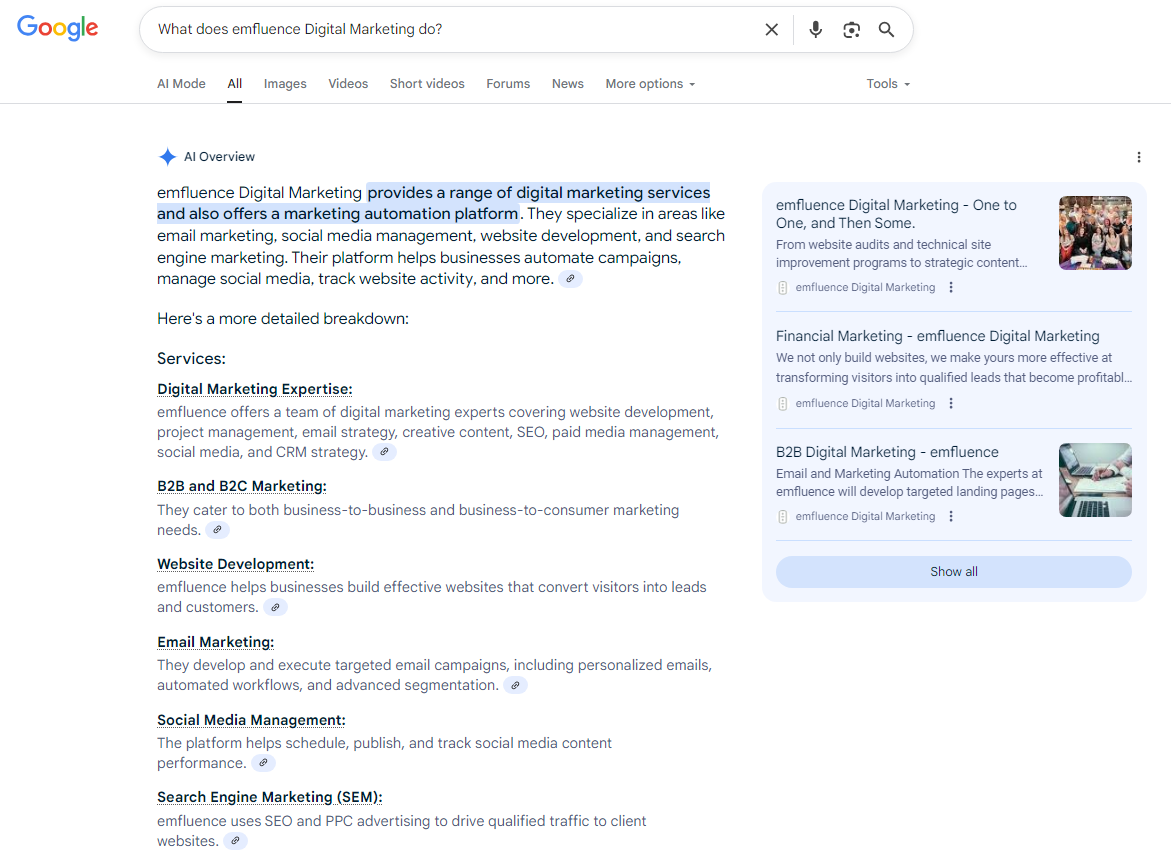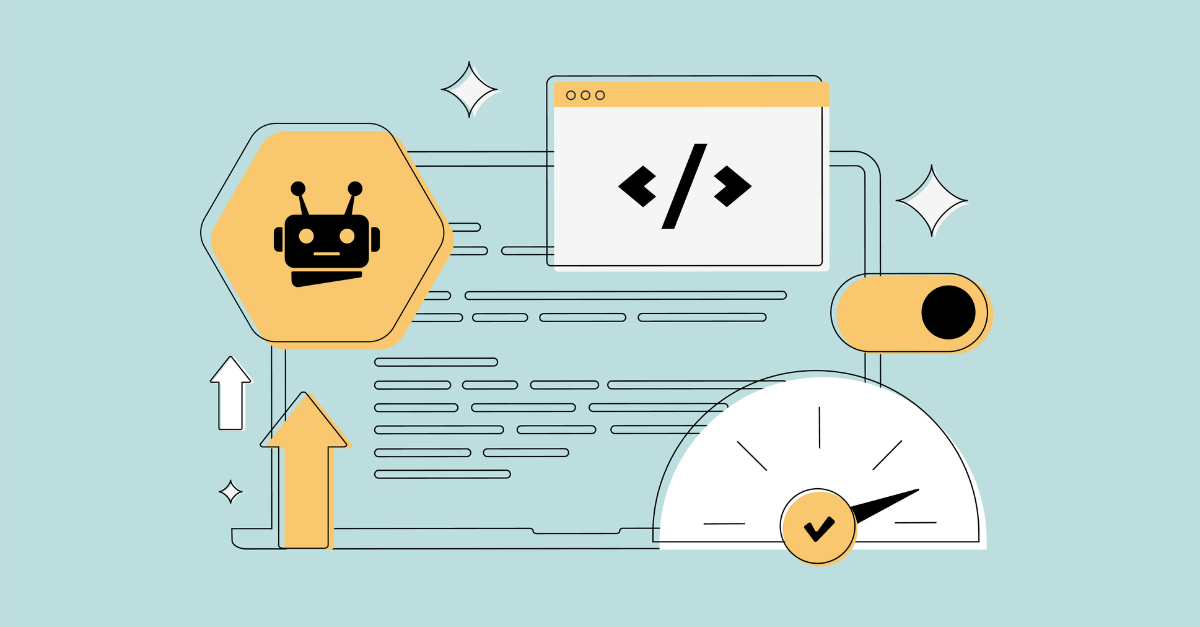Google’s Search Generative Experience (SGE), commonly known as AI Overviews, is an AI-powered expansion of Google Search that generates comprehensive, conversational summaries to user questions.
You’ve likely seen these AI-generated summaries appearing at the top of Google searches, pulling information from a variety of sources to deliver a quick answer. But what do they mean for your content strategy? Should you change how your team writes blog posts, landing pages, or thought leadership pieces? Will your organic traffic take a hit?
Let’s break down what we know, what’s changing, and how you can future-proof your organizations’ content strategy.
What Is Google’s SGE, and How Is It Changing the Search Landscape?
Launched in May of 2024, and referred to as an “AI Overview,” Google’s Search Generative Experience (SGE) is reshaping how people interact with Google results.
Rather than pointing users to external websites like a traditional Google search, AI Overviews deliver straightforward answers to search queries directly on the results page, often appearing above both paid and organic listings. These summaries pull from multiple sources and present information in an easy-to-read format that mimics how a knowledgeable human might respond.
The impact is significant. Traditional organic results are being pushed further down the page, and users are increasingly getting what they need without ever clicking a link.
For brands, this means that being referenced inside the AI Overview is quickly becoming just as important as ranking on page one. Visibility is no longer about position alone, it’s about presence inside the new search experience.
Will SGE Reduce Organic Traffic to My Site?
Yes, in some cases it will, especially for early-stage, top-of-funnel, or informational queries. Read on for some data points that marketing leaders should be aware of in 2025.
Key trends in organic traffic decline:
- Click-through rates are dropping: Even high-ranking sites are seeing sharp declines in CTR because AI-generated answers and rich snippets satisfy user queries before they reach traditional links.
- Zero-click searches are on the rise: Up to 65% of Google searches now end without the user clicking on any result, as answers are provided directly on the search results page.
- Organic traffic is falling: As a result of these trends, industry reports now show that organic traffic has dropped between 15% to 64%, depending on the niche and type of website.
The shift doesn’t bring about the decades-old rhetoric that “SEO is dead” but it does mean the rules are changing.
What Kinds of Content Show Up in AI Overviews?
Google’s AI favors content that is:
- Written for user intent– such as product reviews, comparisons, definitions, recipes, how-to guides, and tutorials
- Clear and well-structured, with concise language and simple formatting
- Credible and reliable, with strong EEAT signals (Experience, Expertise, Authoritativeness, and Trustworthiness)
- Cited and sourced, either through outbound links or embedded credibility markers

How Can I Optimize My Blog or Landing Pages to Be Included in AI Overviews?
Want your content to earn a spot in AI Overviews? It needs to align with how Google’s AI interprets search intent, identifies credible sources, and surfaces concise, relevant answers. Here’s how to get started:
1. Start with a direct answer
Open each page or key section with a clear, fact-based response to the core question. Google looks for content it can extract quickly, so lead with the “what” before the “why.”
2. Go deeper than surface-level content
Address topics in depth, anticipate follow-up questions, and include supporting context that helps both users and AI fully understand the subject.
3. Demonstrate credibility
Trust signals matter more than ever. Cite reputable sources, include author bios or credentials, and keep content updated.
4. Ensure your content is accessible and fast
Keep your site mobile-friendly, crawlable, and quick to load. Google still prioritizes technical quality and a seamless user experience when deciding which content to trust.
What Writing Techniques Work Best for SGE Visibility?
Try these writing techniques to make your content more AI friendly and boost SGE visibility:
- Use H2s and H3s that connect to common user questions.
- Break up content with bullet points, short sentences, and clear formatting.
- Write definition-style responses to high-level queries.
- Include structured comparison tables, pros and cons, and benefits lists.
Think of your content as source material for an AI writer. Clarity, structure, and utility win.
Is Structured Data and Schema Still Important for SGE ?
Yes, schema is still essential. Google uses it to understand content layout and surface rich results. While SGE does not rely entirely on structured data, pages that use it well are easier for AI to parse.
Use JSON-LD format, ensure your markup reflects the actual content on the page, and keep details updated over time. Clean structure plus strong writing is still the winning combination.
How Do I Audit and Adapt Existing Content for SGE?
Auditing existing content is a practical first step toward SGE visibility. Focus on pages that already perform well and refine them to match what Google’s AI prefers.
1. Identify high-value pages
Use analytics to find pages that rank highly, drive the most organic traffic, or support key conversions. These pages are your top candidates for SGE optimization.
2. Check for AI Overview opportunities
Search your target queries and see if AI Overviews appear. Note which websites are cited and how their content is structured.
3. Expand and deepen content
Add comprehensive coverage by answering related questions, updating outdated info, and including recent data or authoritative sources.
4. Lead with clear answers
Revise introductions to provide direct, concise answers near the top. Use subheadings that reflect common user queries and improve scannability with bullet points or FAQs.
5. Refresh structured data
Add or refresh schema markup (JSON-LD format) to accurately represent your content and help Google’s AI better understand your pages.
Is Traditional SEO Still Relevant in the SGE Era?
Yes, but the focus is evolving. Core SEO elements like site speed, mobile optimization, and authority are still foundational , but they’re no longer the whole story. With AI Overviews now appearing above traditional listings, visibility depends on both rankings and relevance to AI-generated summaries.
To adapt, many marketers are embracing Generative Engine Optimization (GEO) as a complement to traditional SEO. This approach focuses on getting content cited in AI-generated results, not just ranked.
TLDR: How to Adapt Content Strategy in the SGE Era
- SGE changes the top of the SERP. AI Overviews often appear above both paid and organic results, driving more zero-click searches.
- Clarity and structure are essential. Use direct answers, question-based headings, and clean formatting to help AI extract your content.
- Visibility now means more than ranking. Getting cited in AI Overviews builds trust, even if users never visit your site.
- Content must demonstrate authority. Focus on depth, accuracy, and up-to-date information. Cite sources and show expertise.
- Schema still matters. Implement JSON-LD, ensure accuracy, and keep it aligned with on-page content.
- SEO strategy must evolve. Optimize for both traditional rankings and inclusion in AI-generated answers.
Ready To Future-Proof Your Content?
At emfluence, we help brands adapt to change, and Google’s AI shift is one of the biggest yet.
Whether you’re looking for a content audit or guidance on schema implementation , emfluence can help you show up where it matters most.
To learn more, schedule a call with one of our marketing experts today at expert@emfluence.com.



